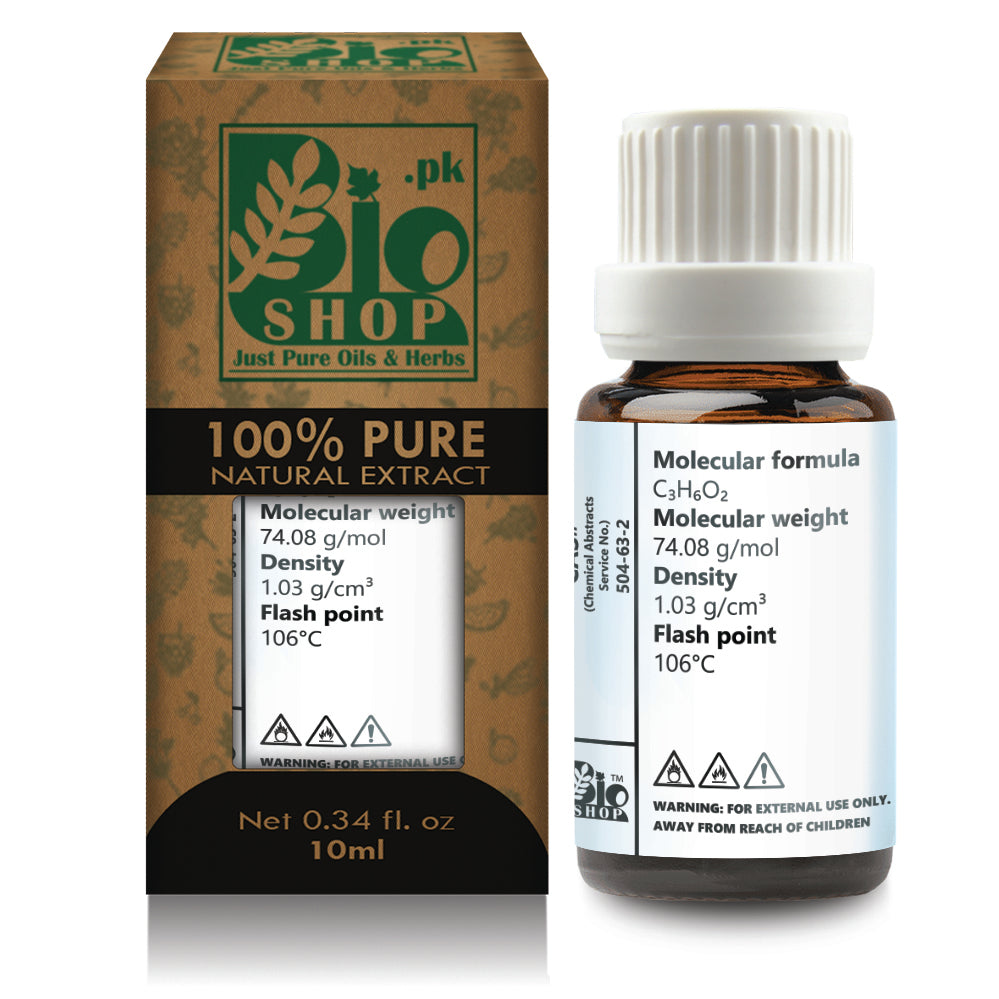Bio Shop
Propanediol
Propanediol
Key Functions: Acts as a humectant, solvent, preservative booster, and penetration enhancer in cosmetic formulations.
Couldn't load pickup availability
Explore
Information About Propanediol
✅ Key Features
- Plant-derived alternative to propylene glycol
- Enhances absorption of active ingredients
- Solubilizes many difficult-to-dissolve ingredients
- Non-irritating and suitable for sensitive skin
- ECOCERT and COSMOS approved
🔬 Description
Propanediol (1,3-Propanediol) is a biobased glycol derived from fermented corn sugar, used in personal care as a multi-functional ingredient. It works as a natural solvent, hydrating agent, and sensory enhancer. Propanediol improves the spreadability, preservative efficacy, and bioavailability of actives. Unlike Propylene Glycol, Propanediol is non-sensitizing and ideal for clean beauty, serums, lotions, and extracts where skin-friendliness is a priority.
📊 Technical Data
INCI Name: Propanediol
CAS Number: 504-63-2
Solubility: Water-soluble, alcohol-soluble
Add Phase: Water phase or post-emulsification
pH Stability: Stable between pH 3.0 – 10.0
Processing Temperature: Up to 80°C
Appearance: Clear, colorless, viscous liquid
Odor: Odorless to slightly sweet
Molecular Formula: C₃H₈O₂
Molecular Weight: 76.09 g/mol
Flash Point: ~120°C
Density: ~1.05 g/cm³
Chemical Type: Glycol / Humectant / Solvent
Functional Groups: Hydroxyl (-OH) x2
Primary Cosmetic Uses: Solvent, humectant, preservative booster, penetration enhancer
🧪 Recommended Usage
- Usage Rate: 1% – 10% (up to 75% in botanical extracts)
- Phase: Add to water phase or use as solvent for actives
- Ideal For: Serums, Toners, Actives, Creams, Gels, Natural Preservative Systems
💡 Pro Tip
🧪 Use Propanediol to dissolve hard-to-dissolve actives like Azelaic Acid, Ferulic Acid, or Allantoin before incorporating into water-based serums or lotions — no alcohol needed!
👩🔬 Skin Type Compatibility
✔️ Safe and non-irritating for all skin types
✔️ Especially good for sensitive and reactive skin
✔️ Suitable for both leave-on and rinse-off products
🧴 Formulation Ideas
1. Hydrating Facial Serum
Use 5% Propanediol with hyaluronic acid and niacinamide for a non-sticky serum that deeply hydrates and enhances active delivery.
2. Azelaic Acid Gel
Pre-dissolve azelaic acid in Propanediol and blend with a gel base (e.g. hydroxyethylcellulose) for an effective anti-acne and brightening treatment.
3. Natural Extract-Based Toner
Use Propanediol as the carrier for botanical extracts like green tea or cucumber to avoid alcohol-based irritation.
4. Makeup Setting Spray
Formulate a lightweight facial mist using Propanediol, rose water, glycerin, and sodium PCA to hydrate and lock in moisture without shine.
5. Oil-Free Moisturizer
Combine Propanediol with sodium lactate, panthenol, and light esters in an emulsion for a silky, oil-free daily cream.
💧 Cosmetic Suitability:
Performance rating based on solvent power, skin compatibility, and functional flexibility.
Serums
⭐⭐⭐⭐⭐ – Excellent
🟩🟩🟩🟩🟩 – Boosts hydration, enhances solubility, non-sticky.
Creams & Lotions
⭐⭐⭐⭐⭐ – Excellent
🟩🟩🟩🟩🟩 – Adds smoothness, aids emulsification, boosts absorption.
Toners
⭐⭐⭐⭐⭐ – Excellent
🟩🟩🟩🟩🟩 – Alcohol-free solvent for gentle skin hydration.
Face Masks
⭐⭐⭐⭐☆ – Good
🟩🟩🟩🟩⬜ – Supports humectancy in cream and gel masks.
Cleansers
⭐⭐⭐⭐☆ – Good
🟩🟩🟩🟩⬜ – Adds mild hydration and enhances texture.
Hair Masks
⭐⭐⭐⭐☆ – Good
🟩🟩🟩🟩⬜ – Adds slip and draws moisture into strands.
Deodorants
⭐⭐⭐⭐☆ – Good
🟩🟩🟩🟩⬜ – Mild and non-irritating carrier for actives.
Eye Creams
⭐⭐⭐⭐☆ – Good
🟩🟩🟩🟩⬜ – Suitable for delicate skin due to low irritation potential.
Shampoos
⭐⭐⭐⭐☆ – Good
🟩🟩🟩🟩⬜ – Enhances conditioning and boosts mildness.
Soaps
⭐☆☆☆☆ – Poor
🟥⬜⬜⬜⬜ – Not used in cold/hot process soaps.
Conditioners
⭐⭐⭐⭐☆ – Good
🟩🟩🟩🟩⬜ – Adds slip and improves feel in emulsions.
Lip Balms
⭐☆☆☆☆ – Poor
🟥⬜⬜⬜⬜ – Not suitable for oil-only systems.
Body Butters
⭐⭐☆☆☆ – Fair
🟧🟧⬜⬜⬜ – Works in emulsified butters; not in anhydrous ones.
❓ FAQs
Q1: Is Propanediol the same as Propylene Glycol?
A1: No. Propanediol is plant-derived, less irritating, and more skin-friendly than petroleum-based Propylene Glycol.
Q2: Can it replace glycerin?
A2: Yes. Propanediol is less sticky and provides similar humectant effects.
Q3: Does it need a preservative?
A3: It has mild preservative-boosting effects, but a full preservative system is still required for water-based products.
Q4: Is Propanediol suitable for sensitive skin?
A4: Absolutely. It’s gentle, non-sensitizing, and ideal for clean beauty and baby care.
Q5: Can I use it to dissolve actives like ferulic acid?
A5: Yes! It’s one of the best solvents for Azelaic Acid, Ferulic Acid, and Allantoin.
📂 Documentation
Upon request, we will provide.
Where Can You Safely Use Propanediol
Discover how Propanediol performs across different products — rated for safety, stability, and effectiveness.





